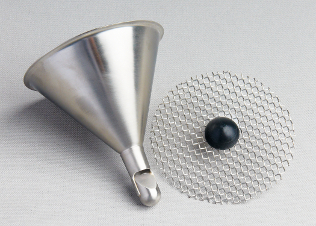The MMC100 Metabolic Cage for use with mice is a free-standing unit designed to accommodate a single mouse for up to a 24 hour period. The cage utilizes a unique blend of features to maximize uncontaminated urine collection.
Cage Features
- Easy to use, assemble, and clean
- Accurately separates urine from feces
- Few components and consumables
- Constructed from durable, impact resistant acrylic
- Stainless steel screen floor and collection funnel
- O-ring seals for rigid connections
- Visual clarity for observation
- Provides 2-5ml collection in a 24 hour period
- Urine vessel is removable and disposable.
- Conforms to recommendations set forth in the Guide for the Care and Use of Laboratory Animals
- Optional Obese and Chiller System Design

The MMC100 Metabolic Cage is manufactured from stainless steel and acrylic components making the cage light weight and rust resistant. Assembly takes less than a minute since there are only eight components, which are as follows:

Components
- Top Cylinder
- Bottom Cylinder
- Screen Floor
- Collection Funnel
- Lid Assembly
- Food and Water Holders
- Urine Collection Vessel
For instructions on how to assemble the MMC100 Metabolic Cage, please visit the Downloads page.
Collection Process
The key to the Metabolic Cage’s high collection rate is the funnel. It captures the urine droplets from the mouse, slowly gathering the liquid on the bulb until enough is present to fall into the collection vessel below. Any extraneous matter that is not impeded by the screen floor, is diverted by the funnel’s walls and shape, inhibiting the material from entering the collection vessel. The outcome is a full, clean sample.


The Metabolic Cage is beneficial for a variety of studies, including (but not limited to):
- Effects of drug therapies
- Renal function studies
- Urinary protein excretion
- Daily food and water intake
- Phenotyping
- Evaluation of standard or intervened metabolic function
- Urinary excretion volume
The cage can also be modified to accommodate obese mice and/or to include insulated bases for integrating with the CCS2000 Chiller System.
Obese Design
There is one difference between the standard Metabolic Cage and the obese design: the arms of the top cylinder sit at a 45˚ angle making the food and water holders easily accessible to overweight mice. The holders are also modified to sit inside the angled arms, as pictured below.
The obese design includes the same features as previously mentioned for the standard design. In addition, while originally designed for obese mice, this cage can also be used with standard mice.

Obese Design Holders

Chiller System Design
Similar to the obese design, the Chiller System Metabolic Cage is almost identical to the standard Metabolic Cage. The only variation is in the bottom cylinder. It is divided into two pieces to include the insulated cage base and base plugs to connect to the Chiller System.
This cage provides a convenient method for maintaining sample temperatures at or below 45˚F (7˚C) throughout the collection process. For more information on how Chiller System, please visit the CCS2000 page.

Modified Chiller Assembly





